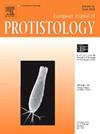哈萨克斯坦尼维菌黏菌(阿米巴虫)的首次记录
IF 1.6
2区 生物学
Q4 MICROBIOLOGY
引用次数: 0
摘要
我们提出了在哈萨克斯坦,特别是阿拉木图附近的阿拉托岛山脉进行的首次硝基黏菌(疟原虫黏菌,阿米巴虫)调查。共采集标本82份,采用比较形态学方法鉴定了16种。除Didymium duum外,所有已确定的物种都是哈萨克斯坦的首次记录。DNA条形码证实了70个标本的形态学鉴定,揭示了26个不同的条形码序列变体。其中,9个18S rDNA条形码变体是新的,以前未在GenBank数据库中报道过。本文章由计算机程序翻译,如有差异,请以英文原文为准。
First records of nivicolous myxomycetes (Amoebozoa) from Kazakhstan
We present the first survey of nivicolous myxomycetes (plasmodial slime molds, Amoebozoa) conducted in Kazakhstan, specifically from the Ile-Alatau mountain range near Almaty. A total of 82 specimens were collected, and 16 species were identified using a comparative morphological approach. Except for Didymium dubium, all identified species represent first records for Kazakhstan. DNA barcoding confirmed the morphology-based identification of 70 specimens, revealing 26 distinct barcode sequence variants. Among these, nine 18S rDNA barcode variants were novel and have not been previously reported in the GenBank database.
求助全文
通过发布文献求助,成功后即可免费获取论文全文。
去求助
来源期刊

European journal of protistology
生物-微生物学
CiteScore
4.60
自引率
20.70%
发文量
55
审稿时长
14.6 weeks
期刊介绍:
Articles deal with protists, unicellular organisms encountered free-living in various habitats or as parasites or used in basic research or applications. The European Journal of Protistology covers topics such as the structure and systematics of protists, their development, ecology, molecular biology and physiology. Beside publishing original articles the journal offers a forum for announcing scientific meetings. Reviews of recently published books are included as well. With its diversity of topics, the European Journal of Protistology is an essential source of information for every active protistologist and for biologists of various fields.
 求助内容:
求助内容: 应助结果提醒方式:
应助结果提醒方式:


